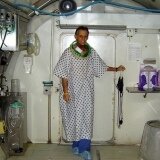Blast Injury and Hyperbaric Oxygenation
Featured article. Page 1.
Acute Brain and Cardio-Respiratory Dysfunction After Blast/Blunt Injuries: The Life-Preserving Effects of Hyperbaric Oxygenation
Gennady G. Rogatsky and Avraham Mayevsky
The Mina & Everard Goodman Faculty of Life Sciences and the Leslie and Susan Gonda Multidisciplinary Brain Research Center, Bar-Ilan University, Ramat-Gan 52900, Israel
ABSTRACT
Today there is an ever-growing necessity to use more aggressive and pathophysiologically adequate techniques of emergency and intensive care in the early stages of modern bombing / blast injuries. The purpose of this review is to present modern data regarding the pathophysiology of the early period of blast injury, focusing on the impairment of hemodynamic and respiration, mostly the role of acute cardio-respiratory and brain dysfunction in the pathogenesis of severe and critical conditions due to blast/blunt injuries. The literature analysis emphasizes the crucial role of early impairment of myocardial contractility in the pathogenesis and outcome of severe traumas established over the course of the last decade in experimental and clinical studies. This review presents the results of laboratory and clinical observations, evidencing the principally important, life-saving effects of the early application of hyperbaric oxygenation in order to correct life-threatening dysfunctions of vital organs (brain, heart, and lungs) resulting from trauma, and to prevent the development of such conditions when trauma consequences are less severe. Also, new data are presented on the possible mechanisms of hyperbaric oxygenation protective effects in cases of severe chest and head injuries. Based on the available literature, we consider the desirability of establishing and employing mobile hyperbaric oxygenation chambers in emergency hyperbaric medicine.
I. INTRODUCTION
The beginning of the 21st century has been marked by unprecedented world-wide terrorist activity, spreading beyond any specific region and perpetrating bombings within large population centers. The resulting massive blast injuries cause high fatalities already in the initial phases of the trauma.115,217 The extent of damage is reported by Rosenfeld et al.185
According to a number of authors26,49,118,125,199,215 the mortality rate increases dramatically when the blast injury occurs in a confined space. In such cases, the mortality may reach 50% of the injured.125,202
Literature analysis indicates that, despite the quite broad reflection on the various aspects of the blast injury problem, the available literature of the past decade includes rather few original investigations regarding the pathophysiology of modern blast injury. Thus, the literature of the recent period (as well as earlier works) include virtually no data on the development of principally new approaches for providing immediate and therapeutically adequate care for contemporary blast injury victims.
Considering the high necessity of such studies, the need for more aggressive patient management tactics124,164 as well as the large disparity of relevant information from different medical fields the purpose of the present work is to provide a review of available literature and the results of our investigations on the subject of closed thoracic and cranial injuries that usually result from a massive explosion wave. This work will present critical pathophysiological data from the literature, directly relevant to the problem under investigation. The work will also present and discuss data regarding the possibilities of hyperbaric oxygenation (HBO2) therapy in conditions of direct injury to vital organs and, correspondingly, their acute functional impairment.
II. PRINCIPAL MECHANISMS OF BLAST INJURIES OF VITAL ORGANS
A. Primary Blast Injury (PBI)
The four basic mechanisms of blast injury (BI) are termed primary, secondary, tertiary and quaternary.9,33,79,135,140,160,170 Primary BI are caused by barotraumas resulting from over-pressurization relative to the atmospheric pressure and are due to the direct effects of the blast wave on the human body.28,85,135,136,160,161
Primary BI most commonly involve air-filled organs and air-filled interfaces. Such organ injuries were modeled in animals by dynamic pressure changes at tissue-density interfaces due to interaction of a high-frequency stress wave and a lower-frequency shear wave.47,85
The lungs are the vital organs that are most vulnerable to PBI. Pressure differentials across the alveolar-capillary interfaces cause a disruption of the tissue and hemorrhage, e.g. damage to the lungs that may include pulmonary contusion,50 34,49,131,134,159,194 with or without laceration, pneumo-hemothorax, traumatic lung cysts, interstitial emphysema, pneumo-mediastinum or subcutaneous emphysema.34,49,51,61,125,135
Intra-pulmonary hemorrhage is the most characteristic sign of the so-called blast lung injury.34,88,98,118,134,164,212,235 On the other hand, the rupture of alveolar and capillary membranes caused by a blast wave, creates the conditions for air-penetration into the vascular system.33,88,160
From the present perspective, pulmonary damage and air-embolization merit special attention when analyzing the pathophysiological mechanisms of primary BI effects on the organism. It is also important to mention the recent original clinical results by Tsokos et al., 216 according to which pulmonary fat embolism may be a leading cause of rapid respiratory deterioration with progressive hypoxia and development of acute respiratory distress syndrome in the surviving blast injury victims.
Generally, the effects of PBI are dramatic, especially on the course and outcome of the trauma. It is sufficient to note that PBI was detected in 57% of the injury survivors and in 86% of fatal outcomes.133 According to Avidan et al.,13 70% of the victims revealed blast lung injury. Kalebi and Olimbe115 point out that, after the terrorist bombing in Nairobi in 1998, 96% of the victims had primary blast injury. According to Pizov et al.,164 death among the victims at the site of explosion or at the moment of hospital admission, was mainly due to blast lung injury.
Clinical data regarding brain injury due to primary blast forces are quite limited. A century of medical literature provides only a handful of cases in which brain injuries are likely to have resulted from primary blast trauma. The reported neuropathological changes have included small hemorrhages within the white matter, chromatolytic changes in neurons, diffuse brain injury and subdural hemorrhage.52,97,126,150,208
According to Phillips and Zajtchuk161 and Taber et al.,209 primary blast injury can cause contusion or traumatic brain injury, although this finding is difficult to distinguish from the concussion due to impact with another object (e.g., in secondary or tertiary blast trauma). Other authors experimental studies on rats presented histological and biochemical evidence for the damaging impact of the primary shock air wave on brain tissue.39, 117
Regarding the effect of primary blast injury on the heart, there are indications that, even though the heart is well protected and not subject to the air/fluid shear of primary blast shock, myocardial contusion can lead to either arrhythmia or hypotension.233
B. Secondary Blast Injury
Secondary blast injuries are caused by bomb fragments and other debris propelled by the intense energy release from an explosion. These flying fragments and debris (depending on their velocity) can produce both penetrating and blunt traumas in the victims body.47,49,125,131,196,216
Secondary blast injury can affect even more traumatic consequences than a primary blast injury. These penetrating wounds do not differ from classical ballistic wounds that are caused by bullets or fragments of conventional explosive munitions.161 Thus, under secondary blast injury, there may appear diverse types of closed and penetrating injuries of the head, as well as of the thoracic and abdominal cavity. These are the leading causes of death and injury in terrorist bombings.132,213
C. Tertiary Blast Injury
This mechanism of blast injury consists, in fact, in blunt trauma sustained when the victim is propelled against a fixed object by a blast wave. Due to the impact, caused by bodily displacement, the victims may develop diverse closed injuries, in various combinations and with various severities: injuries of the head, thorax and abdomen, as well as injuries of the spine, pelvis and extremities, fractures and traumatic amputations, crash injuries from collapsed building fragments. Thus, the mechanisms of damage caused by tertiary blast injuries (in particular, closed head and thorax injury) are very similar to those of traffic accidents, though the course and outcome of the former are more severe.48,61,125,196,204
D. Quaternary Blast Injuries
Quaternary blast injuries include burns (thermal and chemical), toxic inhalation, asphyxiation (including carbon monoxide and cyanide after incomplete combustion of materials), and inhalation of dust containing coal or asbestos. Burns and other quaternary injuries were an important outcome of the attack on the Pentagon on September 11, 2001.65
The up-to-date accumulated experience regarding the diagnosis and treatment of the victims, permits the conclusion that blast injuries, in most cases, represent diverse combinations of the above four mechanisms. The majority of relevant studies point to a combination of blast and blunt effects, flash burns and penetrating wounds.7,21,49,76,125,155,164,211,233 With the recent outburst of various forms of suicide bombings, there is an increased number of penetrating injuries of the head, chest and abdomen.3,4,62,77,121,193
<-<-Previous Page Next Page->->











